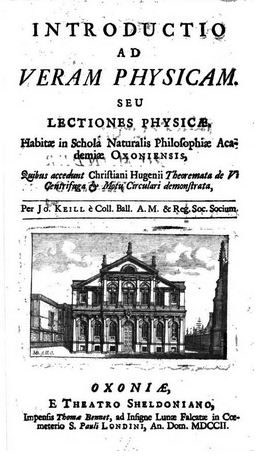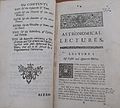John Keill facts for kids
Quick facts for kids
John Keill FRS
|
|
|---|---|
| Born | 1 December 1671 Edinburgh, Scotland
|
| Died | 31 August 1721 (aged 49) Oxford, England
|
| Nationality | Scottish |
| Alma mater | Edinburgh University Balliol College, Oxford |
| Known for | Defending Isaac Newton |
| Scientific career | |
| Fields | Mathematician and astronomer |
| Institutions | University of Oxford |
| Academic advisors | David Gregory |
| Notable students | Brook Taylor John Theophilus Desaguliers |
| Notes | |
|
He is the brother of physician James Keill.
|
|
John Keill (born December 1, 1671 – died August 31, 1721) was a smart Scottish scientist. He was a mathematician, a natural philosopher (someone who studies nature and the universe), and a cryptographer (someone who decodes secret messages). He is best known for strongly supporting Isaac Newton during a big argument about who invented calculus.
Contents
John Keill's Early Life and Studies
John Keill was born in Edinburgh, Scotland, on December 1, 1671. His father, Robert Keill, was a lawyer. John also had a brother, James Keill, who became a famous doctor.
His University Education
Keill studied at Edinburgh University with a teacher named David Gregory. In 1692, he earned his first degree. He did very well in physics and mathematics.
After Edinburgh, Keill went to Balliol College, Oxford. He earned another degree there in 1694.
Teaching Newton's Ideas
Later, Keill became a lecturer at Hart Hall. He started teaching and doing experiments based on Isaac Newton's ideas. He taught his students about the laws of motion. He also explained how hydrostatics (the study of liquids at rest) and optics (the study of light) work. He shared Newton's ideas about light and colors.
Keill's Important Works and Roles
In 1698, Keill published a book called Examination of Dr. Burnet's Theory of the Earth. In this book, he used science to challenge the ideas of other thinkers like René Descartes. This book and his teaching made him well-known in English universities.
Joining the Royal Society
In 1700, John Keill was chosen to be a Fellow of the Royal Society. This is a very important group for scientists. However, he didn't get a teaching job at Oxford in 1709. So, he left the university to look for a job with the government.
Helping War Refugees
In 1709, Keill got a job helping war refugees from Germany. He was in charge of a fund to help them move to new homes. He even traveled with some of these German families to the British Province of New York.
Working for the Queen
In 1711, Keill became a decypherer for Anne, Queen of Great Britain. His job was to help the Queen understand old, difficult writings.
Returning to Oxford
In 1712, Keill went back to Oxford University. He became the Savilian Professor of Astronomy. This was a very important job teaching about stars and planets. In 1713, he earned a higher degree called a DM.
Defending Isaac Newton
In his later years, Keill became deeply involved in a big argument. This argument was about whether Gottfried Leibniz had copied Isaac Newton's invention of calculus. Keill was Newton's main supporter and defender. He argued strongly for Newton. However, Newton eventually felt that Keill was causing too much trouble.
His Family Life
In 1717, Keill married Mary Clements. She was 25 years younger than him. Mary was the daughter of a bookbinder in Oxford. At the time, it was quite unusual for someone from a different social class to marry.
John Keill's Final Years
John Keill died suddenly in London on August 31, 1721. He might have gotten sick from something he ate. He left a will, which is a legal document saying what should happen to his money and belongings. In his will, he left money and items to his wife and his son.
John Keill's Main Books
Here are some of the important books John Keill wrote:
- An Examination of Dr. Burnet's Theory of the Earth. Oxford: 1698.
- Introductio ad Veram Physicam seu Lectiones Physicae (Introduction to True Physics or Physics Lectures). Oxford: Thomas Bennet, 1702.
- Trigonometriae Planae & Sphaericae Elementa (Elements of Plane and Spherical Trigonometry). Oxford: Henry Clements, 1715.
- Item de Natura et Arithmetica Logarithmorum tractatus brevis (Also a Short Treatise on the Nature and Arithmetic of Logarithms). Oxford: Henry Clements, 1715.
- Introductio ad Veram Astronomiam seu Lectiones Astronomicae (Introduction to True Astronomy or Astronomical Lectures). Oxford: Henry Clements, 1718.
Keill's books were very popular. They were printed many times in England and other countries. They were available in Latin, English, and Dutch.
Images for kids





